When a tsunami was triggered off the coast of Japan in 2011 by an undersea 9.0 magnitude earthquake, five nuclear reactors in Fukushima were destroyed causing radiation to spill over onto the land. Some 300,000 people were evacuated and obvious comparisons to Chernobyl were rampant. Kelly Cunningham ’14, then a freshman Park Scholar with her eye on veterinary school, never once considered the possibility that in six years she would find herself at ground-zero, studying the effects of this deadly disaster.
After beginning her studies at Colorado State University’s prestigious veterinary school, Cunningham reached out to a professor in need of a student to assist in a project involving wild pigs. Cunningham, having experience in both wildlife and research, responded to the call and found herself with an opportunity to not only become involved in a fascinating project but also to enrich her veterinary expertise with a master’s degree in cell and molecular biology.
“It was really conveniently laid out,” Cunningham says, “because there was a grant vet students could apply for to fund them to do a whole year [to complete an additional degree]… While it’s a little bit nontraditional for vet students to go do research and have a research mentor, I think it should be strongly encouraged just as the Park program encouraged me to find a mentor in my freshman year. My Park Faculty Mentor, Dr. Bob Grossfeld, always supported me in opportunities to research and travel abroad. I’m thankful that I had his guidance in my undergrad experience.”
She took a full year off from veterinary studies starting in May 2015 (her second year), and in August of this year, defended and received her master’s degree.
“It’s kind of condensed to get it all done, but I think it’s worth it,” she says.
Cunningham and her lab (the same lab collaborating with NASA on the Twin Astronaut Study with Scott and Mark Kelly) spent 3 months in Fukushima working with the Institute for Environmental Radioactivity. They worked with local hunters who would set traps for the wild boar population still living in what is referred to as the “exclusion zone” collecting biological samples for future biodosimetry assessment.
“The whole concept is that you look at chromosomes and extrapolate what dose of radiation an individual receives based on what changes are observed. Historically, we’ve seen that done and we have pretty good lab-developed curves that show you what you should expect. So, if you were present for an atomic bomb or an exposure – a.k.a. acute doses – we know what to expect as a biological effect… but we can’t say the same for chronic exposure. These pigs are living in an environment where they are being exposed to constant levels of radiation.”
When asked about her own safety being exposed to these elements, Cunningham says a temporary research visit is really not as dangerous as it sounds.
“We spent a lot of time on the pavement which very much insulates the radiation exposure… a lot of what we are exposed to is coming from the soil. If we were running around in the dirt and the brush that would be more dangerous,” Cunningham said. “It’s more about the time spent in the area and not so much about being there briefly … We wore what’s called dosimeters – it’ll beep if you go over a certain limit [of radiation.] We still monitored our exposure.”
Cunningham considers herself fortunate to be doing this type of research so soon after the event. With the political tension surrounding the events at Chernobyl, research could not have been handled as effectively or with as comprehensive results as Cunningham and her lab are able to obtain in Fukushima.
After shipping her samples from Japan in December 2016 and arriving back on campus in January of this year, Cunningham spent months staining cells, imaging them under a microscope, and processing the images to add to a large set of data. She has spent these last few months undergoing the tedious process of reviewing and compiling her findings into a publishable manuscript. She will also be presenting her work at the Radiation Research Society Annual Meeting on October 13-18 in Cancun, Mexico.
As for her last two years of vet school, Cunningham will be spending that time preparing for her veterinary career ahead. Her fourth year will be comprised of clinical rotations, usually completed outside of Fort Collins, CO where CSU’s campus is located. It’s no surprise that her interest is leaning toward epidemiology and wildlife, but as far as where in the world that will take her?
“I’ll be ready for a change of scenery… there’ll be lots of cool places.”
Story by Lauren Caddick
posted 2017.09.01


